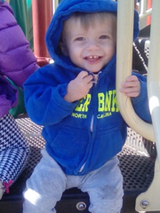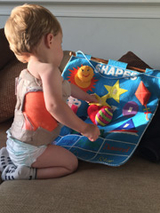Early-onset Scoliosis in an Infant: Tristan’s Story
Early-onset Scoliosis in an Infant: Tristan’s Story
Tristan was about 4 months old when his mom Nikki thought his spine looked a little crooked and mentioned it to her husband Pat. “He’s a baby,” Pat said. “They all lean to one side. Don’t worry so much.”
But a few weeks later, a daycare worker noticed a lump on Tristan’s back. His parents took a closer look and knew something was wrong.
The family’s pediatrician agreed Tristan’s spine was curved, but believed the baby would grow out of it. He said it would be extremely rare for an infant to have scoliosis, a spinal deformity that typically affects adolescents and teens. But because Tristan’s parents were so concerned, the pediatrician referred the family to the Spine Program at Children’s Hospital of Philadelphia (CHOP).
Finding experts

In December 2015, Tristan’s family met with Patrick J. Cahill, MD, a Pediatric Orthopaedic Surgeon with expertise treating children with complex spine conditions, and Susanne Manzoni, RN, at CHOP Specialty Care & Surgery Center in Bucks County, near the family’s home in Warrington, PA.
Dr. Cahill noted that Tristan was leaning abnormally to the right and his ribs appeared to protrude on his left side — strong indicators of scoliosis.
Dr. Cahill explained scoliosis often has no known cause, and early-onset scoliosis — which he believed Tristan had — can affect very young children. An X-ray showed that Tristan had a 36-degree spinal curve and a 23-degree spinal rotation. To achieve the best outcomes for Tristan, treatment should begin immediately, Dr. Cahill advised.
Infant scoliosis treatment options

Two treatments were possible at Tristan’s young age: traditional bracing and serial body casting. Dr. Cahill informed the family about both options, but said the ultimate decision was theirs.
Back bracing has been around for generations and has proved to be very successful in halting the progression of scoliosis. Custom-made back braces reduce pressure on the lower back and help prevent a child’s condition from worsening. However, many children who receive this non-invasive treatment will later require spine surgery to permanently straighten the spine.
Serial body casting is a treatment becoming more widely adopted that is often recommended for children between the ages of 6 months and 6 years with X-ray measurements that indicate their spinal curve will likely get worse. Unlike a brace, the cast has the potential to partially or completely straighten the curve, which could delay or prevent the need for later spine surgery. In order for the cast to be applied, the child must go under anesthesia, which can be frightening for parents.
“We knew Tristan was going to need casting eventually but we didn’t know if we should wait until he was a year or 18 months old to start,” Nikki says.
But Tristan’s parents kept thinking about what Dr. Cahill had said about casting: the sooner it started, the better the outcome. And, casting offered something bracing didn’t — the possibility of a cure. They decided to start serial casting at Children’s Hospital of Philadelphia with Dr. Cahill when Tristan was 6 months old.
Casting at 6 months old
In February 2016, Tristan’s family came to CHOP’s Main Campus for his first casting procedure. Board-certified pediatric anesthesiologists with special training in the effects and dosages of anesthesia in children administered Tristan’s medication. Surgeons then used the elongation-derotation-flexion technique to gently manipulate Tristan’s spine into a straighter position.
Once his body was being held in the proper position, a custom-built body cast (known as a Mehta cast) was formed around his torso. The plaster cast covered Tristan’s trunk from his arm pits to his pelvis, and had a cutout for his belly. The procedure took less than 45 minutes, and Tristan was able to go home the same day.
For a few days after the procedure, Tristan was a bit cranky and uncomfortable as his body adjusted to the new position of his spine, his mom says. But the baby quickly returned to his normal, bubbly self.
Path to a cure
Every six weeks, Tristan returned to Children’s Hospital to have the old cast removed, X-rays taken and a new cast applied. Because Tristan was so young, his spine was very flexible — making him an ideal candidate for the serial Mehta casting that was slowly straightening his spine.
Weekly physical therapy sessions helped Tristan adjust to the bulky cast and reach developmental milestones like crawling and walking.
On Dec. 4, 2016, the final cast was removed. X-rays confirmed the therapy worked: Tristan’s spine curvature was less than 10 degrees — within normal range. He no longer has scoliosis.
“Fifteen years ago, Tristan wouldn’t have had this opportunity,” Pat says. “He wouldn’t be cured by age 2.”
A bright future
Today, Tristan wears a temporary back brace to ensure his spine curvature doesn’t return as his spine continues to grow and harden. The brace has a hard shell and soft lining like the cast did, but it’s less bulky and can be removed for an hour each day.
Under the care of Dr. Cahill and Jason Smith, PA, Tristan will be gradually weaned off the brace, decreasing the number of hours he wears it each day until it is no longer needed.
For now, Tristan is just enjoying being a toddler. He loves running around, going down the slide at the playground, watching Elmo, and spending time with his 4-year-old brother Brayden and 8-month-old sister Charley.
“Tristan is a really happy kid,” Nikki says. “He’s very affectionate and very determined. He doesn’t let anything slow him down.”
Paying it forward

Tristan’s family says they had a “great experience” at Children’s Hospital of Philadelphia. “Dr. Cahill and Susanne were very knowledgeable and accommodating,” Nikki says. Pat adds, “We could not have received better care.”
The family was so grateful to CHOP for the care they received that they have organized an Early-onset Scoliosis Awareness Day with the Philadelphia Phillies.
Hundreds of families will attend a game to celebrate children with early-onset scoliosis, raise funds to support scoliosis care and research at CHOP, and help build a local early-onset scoliosis support network in the greater Philadelphia metropolitan area.
“We want to celebrate kids like Tristan and publicly recognize all they’ve been through,” Nikki says. “We wouldn’t be here today without the Children’s Hospital of Philadelphia.”